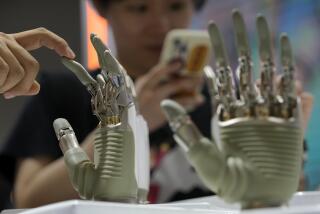How Labor-Saving Computers Can Make More Jobs
You walk into a room, the temperature adjusts to your liking, appliances respond to your voice command. Like George Jetson in the space cartoon, you say “get me an ice-cold soda” and a robot scoots over with a frosty glass.
The technical capability for that futuristic scene is already here--decentralized computer nodes control heat, light, fire control, security and desktop appliances in buildings in Paris, London and St. Louis. Tiny Echelon Corp., in Palo Alto, Calif., has developed a chip-based network that gives elevators the ability to communicate with light fixtures, heating and air conditioning units and security monitors.
But it’s not Big Brother taking over building maintenance. On the contrary, the computer nodes in the Echelon system stand alone and communicate through wiring or radio waves. There is no central computer backing them up.
Welcome to the era of decentralized, individual computing, which will be both metaphor and driving force for the whole economy. M. Kenneth Oshman, president of Echelon and a veteran entrepreneur, predicts that 3.5 billion of his company’s computer nodes will be installed worldwide within the decade. They will reduce the need for energy, raw materials, manual labor.
The implications are profound. Even today as computers do more work, productivity is rising in the United States--strongly increasing the national economic pie for the first time in 20 years.
But anxiety is rising, too. People fear for their jobs as corporations restructure continually. IBM with over 300,000 employees ponders splitting into nine companies, while new leaders in the computing revolution have relatively few employees. Microsoft, Intel, Sun Microsystems employ 11,000 to 20,000 each.
Articles even in the Wall Street Journal warn that productivity gains may bring vast unemployment.
Happily, such worries are mistaken. The growth of massively decentralized computing will only encourage an existing trend toward new patterns of industry, with more companies producing more customized goods and services for individual needs and tastes. There will be more output and employment in the United States, not less, because the advancing technology favors the developed society, not the low-labor-cost one.
Nothing is automatic, however. If you think clearly about new trends, you can see: Why the United States, as technological leader, must fight for open markets around the world; why some form of portable health insurance, and lifelong education and retraining are necessities.
For a look at industry’s new pattern, begin with Echelon itself, started five years ago by A.C. “Mike” Markkula, a founder of Apple Computer, and run by Oshman, one of the founders of ROLM Corp., developer of the PBX office phone system. The firm has 120 employees, 500 customers and roughly 60 patents. And yet the critical part of its product, the Neuron chip, is manufactured by Motorola and Toshiba, big companies that have invested $20 million in Echelon.
“You don’t use valuable resources to reinvent the wheel,” says Oshman. Echelon sees its job as creating and organizing the software and circuitry that make up the computer node--manufacturing chips is somebody’s else’s task.
Sun Microsystems, a leading maker of powerful computers for engineering and production, reflects a similar pattern. Sun was formed 11 years ago by entrepreneurs who developed a product from off-the-shelf computer parts. Today it has $4 billion in sales but only 13,500 employees. One reason, explains its president, Scott McNealy, is that Sun relies on outside agencies to sell two-thirds of its products. And it counts on backers such as AT&T; and Fujitsu to help with research.
In Post-Capitalist Society, writes Peter Drucker in his new book by that name, “organizations will concentrate on their core tasks. For the rest, they will work with other organizations in a bewildering variety of alliances and partnerships.”
In one sense the model is Japanese. Toyota, Nissan and Honda employ fewer than 100,000 employees each, compared to double or triple that number for U.S. auto firms. The Japanese car makers rely on separate suppliers, who pay wages and benefits for many workers, but also sell to other customers, thereby spreading costs and ensuring economies for their main customers, Toyota, Nissan and Honda.
In another sense the new pattern reflects the computer’s ability to equalize the cost of labor--to allow the United States to produce more economically than low-wage countries.
Sun Microsystems, for example, is having great success in China, which needs computers because it recognizes that “technology has outraced menial hand labor,” says McNealy. “A technology oriented farm, using soil management, automated production and distribution just blows away free labor picking the crop.”
The reason is productivity--more output thanks to technology than labor alone can muster.
The upshot is that new computing will bring on a multitude of companies--creating multitudes of jobs one by one. That’s happening already. Dun & Bradstreet, the credit agency, says that more than 660,000 companies were formed last year--adding to the 10 million U.S. companies in D&B;’s database. Significantly, with less than 10% of the world’s population, the United States has 40% of the world’s companies--because its economy is more productive.
U.S. negotiators must fight to open world markets to ensure maximum opportunity for those productive companies. And, in the midst of headlong job shifting, employees must be able to count on essential benefits such as health care and opportunities for training. Productivity makes the pie bigger, after all, so no one should be left out.






